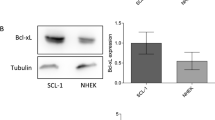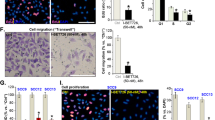Abstract
Teriflunomide (TFN) reportedly inhibits de novo pyrimidine synthesis and exhibits anti-inflammatory, disease-modifying activities in vivo. These qualities would suggest that TFN could be useful in skin cancer chemoprevention or therapy. We investigated some mechanistic aspects of this tenet by characterizing the effects of TFN on premalignant and malignant human cutaneous keratinocytes. TFN promoted a dose- and/or time-dependent cytostasis and in these cells, which was followed by apoptosis. These features occurred in the presence of a physiological concentration of uridine in the culture medium. The short-term S phase arrest triggered by TFN was reversible in the malignant keratinocytes, and the indirect apoptosis induction was apparently preceded by mitochondrial disruption and reactive oxygen species production in both the premalignant and malignant keratinocytes. Respiration deficient malignant keratinocytes were resistant to the acute cytostatic and latent apoptotic effects of TFN implicating de novo pyrimidine synthesis and mitochondrial bioenergetics as the primary targets for TFN in the respiring cells. These novel mechanistic findings support a role for TFN in skin cancer chemoprevention and therapy.








Similar content being viewed by others
Abbreviations
- DHODH:
-
Dihydroorotate dehydrogenase
- DCF:
-
Dichlorofluorescein
- DiOC6(3):
-
3,3′-dihexyloxacarbocyanine iodide
- FBS:
-
Fetal bovine serum
- KRB:
-
Krebs-Ringer buffer
- Me2SO:
-
Dimethyl sulfoxide
- ∆Ψm :
-
Mitochondrial inner transmembrane potential
- mtDNA:
-
Mitochondrial DNA
- PI:
-
Propidium iodide
- ρ0 :
-
Respiration-deficient cells lacking mtDNA
- ROS:
-
Reactive oxygen species
- SCC:
-
Squamous cell carcinoma
- TFN:
-
Teriflunomide
References
Hail N Jr, Lotan R (2004) Apoptosis induction by the natural product cancer chemopreventive agent deguelin is mediated through the inhibition of mitochondrial respiration. Apoptosis 9:437–447
Evans DR, Guy HI (2004) Mammalian pyrimidine biosynthesis: fresh insights into an ancient pathway. J Biol Chem 279:33035–33038
Davis JP, Cain GA, Pitts WJ, Magolda RL, Copeland RA (1996) The immunosuppressive metabolite of leflunomide is a potent inhibitor of human dihydroorotate dehydrogenase. Biochemistry 35:1270–1273
Jöckel J, Wendt B, Löffler M (1998) Structural and functional comparison of agents interfering with dihydroorotate, succinate and NADH oxidation of rat liver mitochondria. Biochem Pharmacol 56:1053–1060
Tallantyre E, Evangelou N, Constantinescu CS (2008) Spotlight on teriflunomide. Int MS J 15:62–68
Breedveld FC, Dayer JM (2000) Leflunomide: mode of action in the treatment of rheumatoid arthritis. Ann Rheum Dis 59:841–849
Clark LC, Combs GF Jr, Turnbull BW et al (1996) Effects of selenium supplementation for cancer prevention in patients with carcinoma of the skin. A randomized controlled trial. Nutritional prevention of cancer study group. JAMA 276:1957–1963
Einspahr JG, Stratton SP, Bowden GT, Alberts DS (2002) Chemoprevention of human skin cancer. Crit Rev Oncol Hematol 41:269–285
Boukamp P, Popp S, Bleuel K, Tomakidi E, Bürkle A, Fusenig NE (1999) Tumorigenic conversion of immortal human skin keratinocytes (HaCaT) by elevated temperature. Oncogene 18:5638–5645
Hail N Jr, Lotan R (2001) The synthetic retinoid CD437 promotes rapid apoptosis in malignant human epidermal keratinocytes and G1 arrest in their normal counterparts. J Cell Physiol 186:24–34
Hail N Jr, Lotan R (2001) Mitochondrial respiration is uniquely associated with the prooxidant and apoptotic effects of N-(4-hydroxyphenyl)retinamide. J Biol Chem 276:45614–45621
Hail N Jr, Chen P, Kepa JJ (2009) Selective apoptosis induction by the cancer chemopreventive agent N-(4-hydroxyphenyl)retinamide is achieved by modulating mitochondrial bioenergetics in premalignant and malignant human prostate epithelial cells. Apoptosis 14:449–863
Traut TW (1994) Physiological concentrations of purines and pyrimidines. Mol Cell Biochem 140:1–22
Moyer JD, Oliver JT, Handschumacher RE (1981) Salvage of circulating pyrimidine nucleosides in the rat. Cancer Res 41:3010–3017
Lecca D, Ceruti S (2008) Uracil nucleotides: from metabolic intermediates to neuroprotection and neuroinflammation. Biochem Pharmacol 75:1869–1881
Löffler M, Becker C, Wegerle E, Schuster G (1996) Catalytic enzyme histochemistry and biochemical analysis of dihydroorotate dehydrogenase/oxidase and succinate dehydrogenase in mammalian tissues, cells and mitochondria. Histochem Cell Biol 105:119–128
Baumann P, Mandl-Weber S, Volkl A et al (2009) Dihydroorotate dehydrogenase inhibitor A771726 (leflunomide) induces apoptosis and diminishes proliferation of multiple myeloma cells. Mol Cancer Ther 8:366–375
Rückemann K, Fairbanks LD, Carrey EA et al (1998) Leflunomide inhibits pyrimidine de novo synthesis in mitogen-stimulated T-lymphocytes from healthy humans. J Biol Chem 273:21682–21691
Shawver LK, Schwartz DP, Mann E et al (1997) Inhibition of platelet-derived growth factor-mediated signal transduction and tumor growth by N-[4-(trifluoromethyl)-phenyl]5-methylisoxazole-4-carboxamide. Clin Cancer Res 3:1167–1177
Ringshausen I, Oelsner M, Bogner C, Peschel C, Decker T (2008) The immunomodulatory drug Leflunomide inhibits cell cycle progression of B-CLL cells. Leukemia 22:635–638
Sawamukai N, Saito K, Yamaoka K, Nakayamada S, Ra C, Tanaka Y (2007) Leflunomide inhibits PDK1/Akt pathway and induces apoptosis of human mast cells. J Immunol 179:6479–6484
Xu X, Williams JW, Gong H, Finnegan A, Chong AS (1996) Two activities of the immunosuppressive metabolite of leflunomide, A77 1726. Inhibition of pyrimidine nucleotide synthesis and protein tyrosine phosphorylation. Biochem Pharmacol 52:527–534
Sirri V, Urcuqui-Inchima S, Roussel P, Hernandez-Verdun D (2008) Nucleolus: the fascinating nuclear body. Histochem Cell Biol 129:13–31
Montanaro L, Trere D, Derenzini M (2008) Nucleolus, ribosomes, and cancer. Am J Pathol 173:301–310
Hail N Jr (2005) Mitochondria: a novel target for the chemoprevention of cancer. Apoptosis 10:687–705
Hail N Jr, Lotan R (2002) Examining the role of mitochondrial respiration in vanilloid-induced apoptosis. J Natl Cancer Inst 94:1281–1292
Fontaine E, Ichas F, Bernardi P (1998) A ubiquinone-binding site regulates the Mitochondrial permeability transition pore. J Biol Chem 273:25734–25740
Hail N Jr (2008) Mitochondrial reactive oxygen species affect sensitivity to curcumin-induced apoptosis. Free Radic Biol Med 44:1382–1393
Pletjushkina OY, Lyamzaev KG, Popova EN et al (2006) Effect of oxidative stress on dynamics of mitochondrial reticulum. Biochim Biophys Acta 1757:518–524
Bickers DR, Athar M (2006) Oxidative stress in the pathogenesis of skin disease. J Invest Dermatol 126:2565–2575
Guzman E, Langowski JL, Owen-Schaub L (2002) Mad dogs, Englishmen and apoptosis: the role of cell death in UV-induced skin cancer. Apoptosis 8:315–325
Boukamp P (2005) UV-induced skin cancer: similarities–variations. J Dtsch Dermatol Ges 3:493–505
Acknowledgments
This work was supported by funds provided by the University of Colorado Denver School of Pharmacy. We thank Christine Childs with the University of Colorado Cancer Center Flow Cytometry Core for her assistance with the acquisition of the flow cytometry data presented in this study.
Conflict of interest
The authors declare that they have no conflict of interest regarding the research presented in this publication.
Author information
Authors and Affiliations
Corresponding author
Rights and permissions
About this article
Cite this article
Hail, N., Chen, P., Rower, J. et al. Teriflunomide encourages cytostatic and apoptotic effects in premalignant and malignant cutaneous keratinocytes. Apoptosis 15, 1234–1246 (2010). https://doi.org/10.1007/s10495-010-0518-4
Published:
Issue Date:
DOI: https://doi.org/10.1007/s10495-010-0518-4




